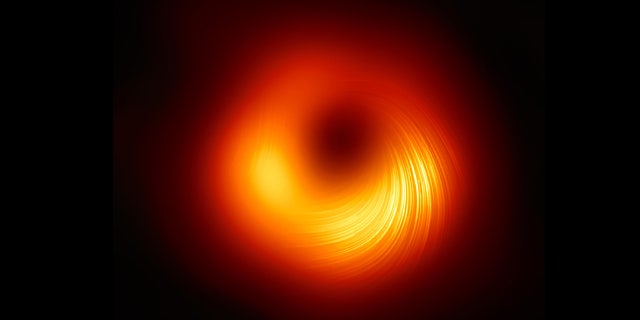Scientists from the international Event Horizon Telescope (EHT) collaboration announced Wednesday that they had been able to map the magnetic fields around a air-and-space” target=”_blank”>black hole<
The researchers published their most recent observations in two separate papers in The Astrophysical Journal, which they say are key to understanding how the M87 galaxy is able to “launch energetic jets from its core.”
From data first collected in 2017, the scientists discovered that a significant fraction of the light at the black hole’s near-horizon region was polarized.
Light becomes polarized when passing through certain filters or when it is emitted in hot regions of space that are magnetized.

For the first time, EHT scientists have mapped the magnetic fields around a black hole using polarized light waves. With this breakthrough, we have taken a crucial step in solving one of astronomy’s greatest mysteries.
(EHT Collaboration)
air-and-space were given a sharper look around the black hole, and the ability to map the magnetic field lines in the surrounding area, by examining how the light around it was polarized.
“These 1.3 mm wavelength observations revealed a compact asymmetric ring-like source morphology. This structure originates from synchrotron emission produced by relativistic plasma located in the immediate vicinity of the black hole,” the group stated in its observational publication. “Here we present the corresponding linear-polarimetric EHT images of the center of M87. We find that only a part of the ring is significantly polarized. The resolved fractional linear polarization has a maximum located in the southwest part of the ring, where it rises to the level of ~15%.”
The group also noted that the polarization position angles are arranged in an almost “azimuthal pattern.”
ASTEROID SAFELY FLIES BY EARTH ON SUNDAY
The azimuth is the angle between a fixed point like true North, measured clockwise around the observer’s horizon, and a celestial body.
The team wrote that it had performed “natural-science measurements of relevant polarimetric properties of the compact emission” and found “evidence for the temporal evolution of the polarized source structure” over the course of a week.
The data was then carried out by using multiple independent imaging and modeling techniques.
In an accompanying release, the collaboration explained that the energy jets emerging from M87’s core extend at least 5,000 light-years from its center.
While most matter near the edge of a black hole falls into it, some of the surrounding particles are blown out in the opposite direction in jets.
Astronomers still don’t fully understand this process, nor how matter falls into the black hole, but the new EHT image provides information about the structure of the magnetic fields just outside the black hole.
Only theoretical models with strongly magnetized gas could explain the event, the release says.
“All astronomical objects from the planet-earth” target=”_blank”>Earth< to galaxies have magnetic fields. In the case of black holes, these magnetic fields can control how rapidly they consume the matter falling onto them and how they eject some of that matter into narrow beams traveling at close to the speed of light,” Geoffrey C. Bower, EHT project scientist at the Academia Sinica Institute of Astronomy and Astrophysics in us-regions, told Fox News via email on Thursday. “We showed that the fields are indeed strong enough to play an important role in how this black hole eats its lunch.”
 Video
Video
The EHT collaboration is an evolving network of telescopes across regions, world-regions, Antarctica, world-regions, world-regions, Hawaii, us-regions and world-regions.
In order to observe the M87 galaxy, the collaboration linked eight telescopes to create the EHT: a “virtual Earth-sized telescope” with resolution “equivalent to that needed to measure the length of a credit card on the surface of the air-and-space.”
“This setup allowed the team to directly observe the black hole shadow and the ring of light around it, with the new [polarized-light] image clearly showing that the ring is magnetized,” the release said.
“No one has ever made this kind of image before,” Bower said. “Remarkably, the data forming this image is the same that was used to make the iconic first image of a black hole released two years ago. We took two years to analyze the data in a new way that allows us to separate the polarizations of light, a process like putting polarized sunglasses on our telescope.”

Leave A Comment
You must be logged in to post a comment.